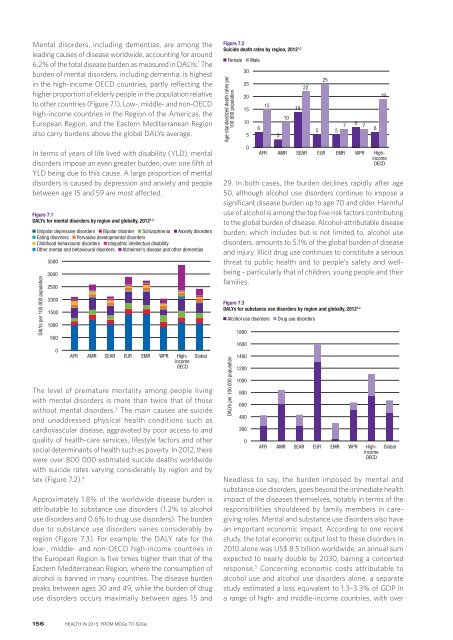You also want an ePaper? Increase the reach of your titles
YUMPU automatically turns print PDFs into web optimized ePapers that Google loves.
Mental disorders, including dementias, are among the<br />
leading causes of disease worldwide, accounting for around<br />
6.2% of the <strong>to</strong>tal disease burden as measured in DALYs. 1 The<br />
burden of mental disorders, including dementia, is highest<br />
in the high-income OECD countries, partly reflecting the<br />
higher proportion of elderly people in the population relative<br />
<strong>to</strong> other countries (Figure 7.1). Low-, middle- and non-OECD<br />
high-income countries in the Region of the Americas, the<br />
European Region, and the Eastern Mediterranean Region<br />
also carry burdens above the global DALYs average.<br />
In terms of years of life lived with disability (YLD), mental<br />
disorders impose an even greater burden, over one fifth of<br />
YLD being due <strong>to</strong> this cause. A large proportion of mental<br />
disorders is caused by depression and anxiety and people<br />
between age 15 and 59 are most affected.<br />
Figure 7.1<br />
DALYs for mental disorders by region and globally, 2012 1,2<br />
Unipolar depressive disorders Bipolar disorder Schizophrenia Anxiety disorders<br />
Eating disorders Pervasive developmental disorders<br />
Childhood behavioural disorders Idiopathic intellectual disability<br />
Other mental and behavioural disorders Alzheimer’s disease and other dementias<br />
DALYs per 100 000 population<br />
3500<br />
3000<br />
2500<br />
2000<br />
1500<br />
1000<br />
500<br />
0<br />
AFR<br />
AMR SEAR EUR EMR WPR<br />
Highincome<br />
OECD<br />
Global<br />
The level of premature mortality among people living<br />
with mental disorders is more than twice that of those<br />
without mental disorders. 3 The main causes are suicide<br />
and unaddressed physical health conditions such as<br />
cardiovascular disease, aggravated by poor access <strong>to</strong> and<br />
quality of health-care services, lifestyle fac<strong>to</strong>rs and other<br />
social determinants of health such as poverty. In 2012, there<br />
were over 800 000 estimated suicide deaths worldwide<br />
with suicide rates varying considerably by region and by<br />
sex (Figure 7.2). 4<br />
Approximately 1.8% of the worldwide disease burden is<br />
attributable <strong>to</strong> substance use disorders (1.2% <strong>to</strong> alcohol<br />
use disorders and 0.6% <strong>to</strong> drug use disorders). The burden<br />
due <strong>to</strong> substance use disorders varies considerably by<br />
region (Figure 7.3). For example, the DALY rate for the<br />
low-, middle- and non-OECD high-income countries in<br />
the European Region is five times higher than that of the<br />
Eastern Mediterranean Region, where the consumption of<br />
alcohol is banned in many countries. The disease burden<br />
peaks between ages 30 and 49, while the burden of drug<br />
use disorders occurs maximally between ages 15 and<br />
Figure 7.2<br />
Suicide death rates by region, 2012 1,2<br />
Female<br />
Age-standardized death rates per<br />
100 000 population<br />
29. In both cases, the burden declines rapidly after age<br />
50, although alcohol use disorders continue <strong>to</strong> impose a<br />
significant disease burden up <strong>to</strong> age 70 and older. Harmful<br />
use of alcohol is among the <strong>to</strong>p five risk fac<strong>to</strong>rs contributing<br />
<strong>to</strong> the global burden of disease. Alcohol-attributable disease<br />
burden, which includes but is not limited <strong>to</strong>, alcohol use<br />
disorders, amounts <strong>to</strong> 5.1% of the global burden of disease<br />
and injury. Illicit drug use continues <strong>to</strong> constitute a serious<br />
threat <strong>to</strong> public health and <strong>to</strong> people’s safety and wellbeing<br />
– particularly that of children, young people and their<br />
families.<br />
Figure 7.3<br />
DALYs for substance use disorders by region and globally, 2012 1,2<br />
Alcohol use disorders<br />
DALYs per 100 000 population<br />
30<br />
25<br />
20<br />
15<br />
10<br />
1800<br />
1600<br />
1400<br />
1200<br />
1000<br />
800<br />
600<br />
400<br />
200<br />
0<br />
5<br />
0<br />
Male<br />
6<br />
AFR<br />
AFR<br />
15<br />
3<br />
10<br />
14<br />
22<br />
AMR SEAR EUR EMR WPR<br />
Drug use disorders<br />
AMR SEAR EUR EMR WPR<br />
Highincome<br />
OECD<br />
Highincome<br />
OECD<br />
Global<br />
Needless <strong>to</strong> say, the burden imposed by mental and<br />
substance use disorders, goes beyond the immediate health<br />
impact of the diseases themselves, notably in terms of the<br />
responsibilities shouldered by family members in caregiving<br />
roles. Mental and substance use disorders also have<br />
an important economic impact. According <strong>to</strong> one recent<br />
study, the <strong>to</strong>tal economic output lost <strong>to</strong> these disorders in<br />
2010 alone was US$ 8.5 billion worldwide, an annual sum<br />
expected <strong>to</strong> nearly double by 2030, barring a concerted<br />
response. 5 Concerning economic costs attributable <strong>to</strong><br />
alcohol use and alcohol use disorders alone, a separate<br />
study estimated a loss equivalent <strong>to</strong> 1.3–3.3% of GDP in<br />
a range of high- and middle-income countries, with over<br />
25<br />
5 5<br />
7<br />
8<br />
7<br />
6<br />
19<br />
156 HEALTH IN 2015: FROM MDGs TO SDGs


